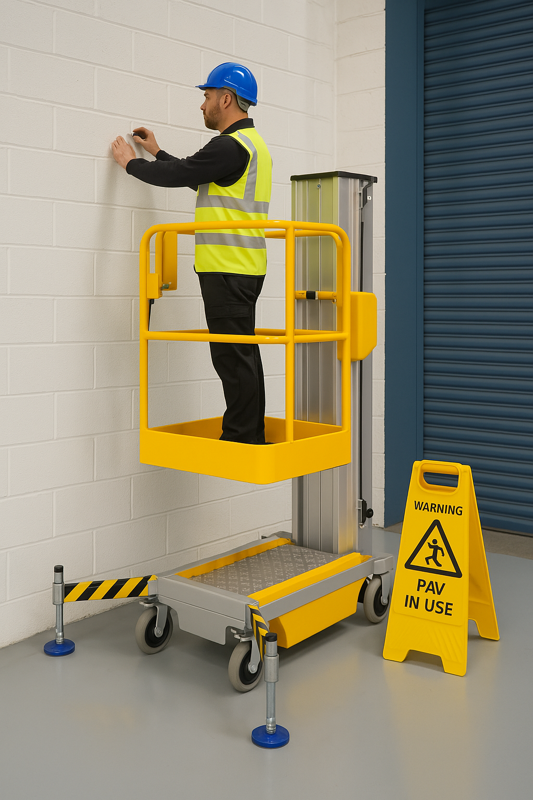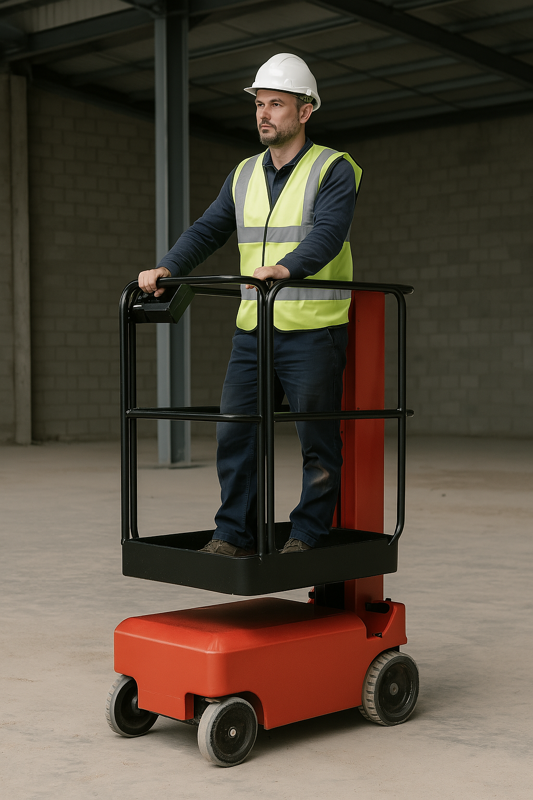
PAV
Push Around Vertical training
“Small Platform. Big Safety.”
Course Objective:
To provide learners with the knowledge and practical skills to safely operate, manoeuvre, and inspect Push Around Vertical (PAV) lifts, in line with health and safety legislation and best practice.

How it works….
On the course
At a glance…
1 - 6 delegates
Half day course
No qualifications
PPE required - hard hat, his-viz clothing, safety boots, other site specific
This training course is delivered on-site at your location or at a training centre location and typically lasts a day, No formal qualifications are needed to attend, making it accessible to all experience levels. Group sizes are kept small, usually between 1–4/6 depending on categories and practical tests on day delegates, this is to ensure focused, hands-on learning. Delegates are required to bring PPE for this training course
Module 1: Introduction to PAV Lifts
This module provides a clear introduction to Push Around Vertical (PAV) lifts—compact, low-level access platforms designed to improve safety when working at height.
You’ll learn:
What a PAV is and how it operates
The typical tasks and industries where PAVs are used, such as maintenance, retail, warehousing, and facilities management
Why PAVs are often a safer, more efficient choice than ladders or step stools
The limitations of PAVs, including reach height, indoor use only, and manual positioning
A breakdown of the key components, including the base, platform, guardrails, controls, and safety features
By the end of this module, you’ll understand how PAVs fit into safe work-at-height practices and where they can be most effectively used.
Module 2: Legal Responsibilities & Safety Standards
Understanding the legal framework is essential when working with PAV lifts. This module outlines the key regulations and safety standards that govern their safe use.
You’ll explore:
The Work at Height Regulations 2005 and how they apply to low-level access
Key requirements under PUWER (Provision and Use of Work Equipment Regulations)
When LOLER (Lifting Operations and Lifting Equipment Regulations) may apply
The legal responsibilities of employers and operators to ensure safe operation
Manufacturer safety guidelines and why following them is critical
HSE guidance specific to PAVs and low-level access equipment
By the end of this module, you’ll know exactly what’s expected to remain compliant, safe, and confident when using a PAV lift.
Module 3: Identifying Hazards and Understanding Risk
This module helps you recognise the most common risks involved in PAV use and how to prevent them. You’ll learn to:
Spot hazards like uneven floors, overhead obstructions, and poor visibility
Understand stability risks and how to avoid tipping
Factor in environmental conditions (indoor vs. outdoor use)
Follow PPE requirements to protect yourself on the job
Module 4: Pre-Use Inspections and Safety Checks
Before using any equipment, safety starts with inspection. This module covers:
How to carry out a thorough daily visual check
Performing essential operational tests
Identifying and reporting faults before they become dangerous
Keeping up-to-date maintenance records
Ensuring safe set-up near walls, ceilings, and fixtures
Module 5: Safe Operation and Manoeuvring
This module walks you through how to operate a PAV safely and efficiently:
How to manually move and position the unit
Securely stabilising the PAV before work begins
Safe techniques for ascending, descending, and working at height
Understanding load limits, reach capacity, and platform restrictions
What to do in case of an emergency lowering situation
Knowledge is important—but hands-on practice makes it real. In this module, learners will:
Practice pre-use checks and safe operation under supervision
Learn how to move, position, and elevate the PAV
Simulate real work tasks at height
Complete a controlled practical assessment to confirm competency

Assessment
To complete the PAV training course, learners must successfully pass both a theory and practical assessment to demonstrate their understanding and competence.
Theory Assessment
A short, multiple-choice quiz covering:
PAV components and safety features
Legal responsibilities (PUWER, WAHR)
Risk assessment procedures
Safe operation, movement, and setup
Emergency protocols and inspection requirements
The theory test ensures learners understand the key principles of safe PAV use before entering the practical stage.
Practical Assessment
Under supervision, learners must demonstrate their ability to:
Conduct pre-use visual inspections
Correctly manoeuvre and position the PAV
Safely ascend, descend, and operate at height
Follow proper shutdown and emergency lowering procedures


